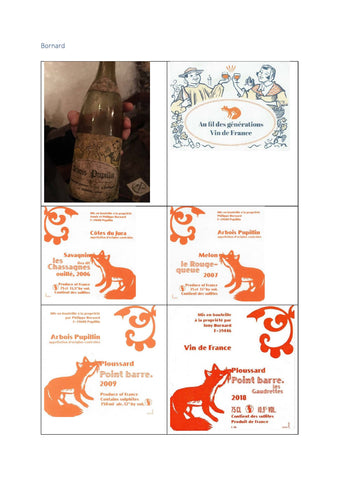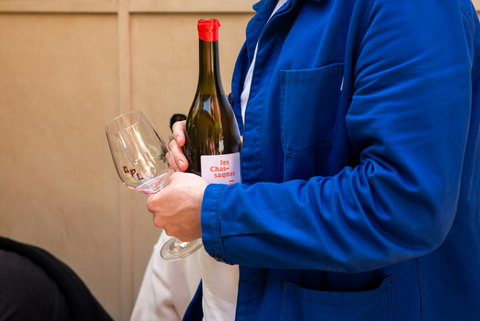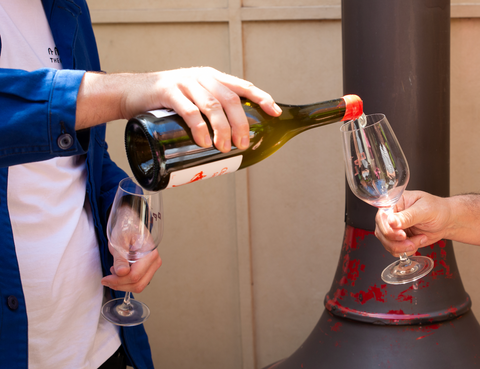In the first part we delved into the wines of Mosse, Loire valley wines of pure energy. In this 2nd part we discuss a living legend in Tony Bornard, a Jura estate that is maybe only rivalled for pure decadence by 'FanFan' Ganevat.
Take it away Sue

SUE
This wine you were about to drink arrived in Australia about six weeks ago, I think, and we opened the box today for this. It's the first time it's been tried in Australia…………………………. so I hope it tastes good.
We really wanted to bring this wine because it's a brand new label and if we continue this same story, it's an even more dramatic family story.
ROGER
You may be too young to know this but in 2008 when we first went to the Jura nobody in Australia.
SUE
2010!
ROGER
oh maybe 2010. That nobody in Australia drank Jura wines except for a few really weird people.
Bahama LLlama
Um, you two.
Sue
And Andrew Guard (Importer)
ROGER
Yeah it just wasn't drunk and it was regarded as off. It was considered faulty because a lot of the wines were oxidative.
SUE
And the red wines, no one understood the red wines because the grape Ploussard was unfamiliar. With the name Ploussard or Poulsard, in the Bornard wines its always Ploussard. But for example, we have wines from Alice Bouvot, from Octavin, It's always Poulsard.
It’s Ploussard in Pupillin, which is a village of 200 people, where the only thing that happens is wine. All the people who live in the village work in the wine industry, including both sides of Philippe Bornard's family.
So both his great-grandparents had vineyards in Pupillin. It's the only place where they call it Ploussard. When you walk in or drive into the village of Pupillin, there's this big sign which says the world capital of Ploussard. And that's because this region is the only place where you can find it. But the variety is so fragile and so light that people didn't understand it outside the region.
ROGER
Now if you, if you look at the label there, you'll see two things on there. Look, three things, sorry, three things on there. Les Chassagnes is the lieu dit that it comes from, Lieu Dit means Named Place. And basically in France there's 34,965 communes…

SUE
He probably learnt that once.
ROGER
They create new communes all the time. So it might be a few more or few less. But, the whole country is divided in communes. Communes are based around a village and each village that has a mairie which is the town hall. So every one of those 34,965 have got a mayor within a commune. Within a commune there are named places or lieu dits and one of those in this commune, one of the named places is Les Chassagnes. So it's a vineyard basically, you can have named places that aren't vineyards. It's just a way of naming and owning or not owning a particular area.
SUE
And that's why you often see the same name for wines from different producers. Because that place won't necessarily all be owned by the Bornards.
(Team interject about land ownership in Burgundy)
Yeah people in Burgundy might only have a couple of rows. So many people use the same name and in this case it's not like in Burgundy where the name is often part of an appellation, it's just the name of a place, but in some places, particularly in Burgundy, those place names become the name of a wine appellation as well.
ROGER
You'll see on this label that it says ‘lieu dit, Les Chassagnes’,
SUE
Look at the difference between that Les Chassagnes and the new one.
(There is a photo of the label from the 2006 vintage on the handout)
And that tells you the story of a very big change.
ROGER
You'll notice at the top of that label Annie and Philippe Bornard. It’s one of the first wines we received but Annie’s name disappeared after another couple of years. Annie was Philippe’s wife.

SUE
Roger said to me one day, have you noticed that Annie's not on the label anymore? And sure enough, when the next time we went to France and we found they had divorced.
They have two children, Charlene and Tony. They came with Phillipe to Australia for a Rootstock. I can't remember which year it was, probably 2018, whenever the last Roodstock was. But many Australians have met them.
ROGER
So Annie and Philippe are on this old one, but on the label for the one we’re drinking (2020 vintage) it's Tony Bornard. Same wine, same name, but different. You also notice something, which goes unnoticed by a lot of people, but you can see a fox. That’s because a lot of people say that Philippe's name Bornard is like Renard, which is the French name for the fox.
ROGER
(We look at a sheet of multiple wine labels from Bornard)
This one - it's pointing that way. And the other two down the bottom are pointing the other way. And that's because the two down the bottom are red and the two in the middle are whites and this one's white. So it actually does convey something else, that it’s a white wine. And the other word that you'll see on the sheet is ouille. That means topped up. So this wine has been topped up so it’s not so oxidative,. But, even so, because they quite often raise them in very old barrels the oxygen gets in through, the pores of the barrel anyway.
SUE
This wine is always in a foudre (a 2000+ litre barrel). Philippe had several of these beautiful old giant barrels as well as his ordinary barrels. They're just so photogenic. These glorious foudre and demi-muids (600 litre) are used usually for the same cuvee. So the Les Chassagne always goes in the same foudre. There's one Ploussard cuvee, the La Chamade, that goes in wood, that is always in the same foudre.
And they've kept that tradition all the time of, and of trying to keep the wines in the same barrel. Whereas if you go to Bordeaux, the objective is often to use a brand new barrel for each year for the first growth type wines.
ROGER
The story the labels represent is that Tony has taken over from Philippe. Now the story with the Mosses is René moved into the background and said, okay, they've got it, I'm not gonna help them because they don't need help, they're gonna make great wine So that's it.
But Philippe sold his business to Tony. Tony's a lovely guy but the problem now is that it's become an acrimonious handover.
All the wine and the cellar equipment was under Phillipe's house but during the last two years Tony built a new winery at the other end of the village.
SUE
Literally as far away in the small village as it could be.
ROGER
We think once his cellars were emptied the impact of retirement and the sale really hit Phillipe.
SUE
I think Philippe thought that when he retired, nothing would change except he would have more holidays and play the guitar. But they actually have very different views, particularly in terms of how to work in the vineyard. Tony's view is that like a lot of vignerons and a lot of vineyards these days that he doesn't want to plough the soil. He wants to try to work in a no-till type of agriculture. So that the micro flora underneath the ground isn't broken up every season.
While Philippe is much more traditional and doesn't really agree with what he is doing. They actually don't speak to each other at the moment which is really, really sad. Tony's just over 40, he turned 40 during covid. Maybe as he gets older they may reunite but at the moment Tony doesn’t think so. I think this label is his attempt to respect the past, but make it so clear that they are now his wines.

Bahama LLama
Do you think that's a little bit to do with the fact that the Jura was once a back water in some ways? And now it's become so well known that people from there are being told how amazing they are so consistently it's gonna change relationships and people who were in many ways just living an agrarian lifestyle?
SUE
I think that that had already happened. Philippe sold at the end of 2017 and by that stage they had already reached the point where they could sell the wine to anyone. He tells a story. There's a really good wine salon (fair) if you ever feel like losing Australian summer and having a French winter. There's a very good wine salon and there's three or four others associated with it in the Loire Valley at the end of January, the beginning of February called Le Dive Bouteille.
If you want to do a fast track education in French natural wine, then that week is a really good week to go to France. Marcel Lapierre, one of the great Beaujolais vignerons, who unfortunately died of cancer some years ago, said to Philippe that he must come to Le Dive. And then when he went to Le Dive Marcel introduced him to an American importer and a Japanese importer, and from then on he could sell anything.
So they were already famous and already had relationships. But I think for Philippe, when everything’s gone, if you go to his house. It's a massive house, at his end of the village, and we go down very narrow stairs into the cellar and then that opens out onto where all the tractors and things were. It’s like a part of him has just vanished.
ROGER
What do you think of the wine?
(team agree it is absolutely delicious. Rich and dense for such a cool region. All balanced by an upright spine)
It is one of my favorites. Even though it’s topped up. I also should also mention the next label here. The 2007 label (which is for a wine called Melon le Rouge-queue).
SUE
We put that in there to show how track the family’s changes. By 2007 Annie’s name has been removed and it is just Philippe (and in 2020 it is just Tony).
(A team member asks if they make a Vin Jaune, the oxidative aged white in the unusual shaped bottles)
SUE
I think probably the Vin Jaune is the only wine Tony will still make in the appellation (following the regulations controls).
ROGER
Just in case you're not aware of it, this wine’s name alludes to the grape it’s made from - Melon-Queue-Rouge. There's a lot of controversy about as to whether it's just Chardonnay or whether it's something else. And I believe it's something else. The locals think it's a mutation that has mutated over the hundreds of years that Chardonnay has been in the Jura.
It is regarded by most of the natural wine community, as being a different grape to Chardonnay. And this is a recognition of that.
SUE
But that's another situation where the appellation refuses to acknowledge it. So according to the appellation, it's Chardonnay, but if you see it growing, Queue-Rouge literally means red tail, and you can actually see the red stem in between the white grapes.
The grape isn't red, it's the stem.
ROGER
The other two labels down the bottom of the page just to round us this off Point Barre, which is made from Ploussard. By the way, the sign that Sue mentioned earlier, is the sign at the start of the village. It used to say ‘Pupillin Vin de Vendange October 17’.
In other words, when they were allowed to start picking was in October 17. They began picking this year at the end of August. The appellation authorities had to back off that rule, because that was a rule written into the cartier de charge, which is the regulations. There's a document for every appellation in France.
And that document said you're not allowed to start picking until October 17th. Well now they've had to rub that rule out because of climate change. ‘Point Barre’ stands for full stop and what the name means is this is Ploussard full stop. Nothing else. Now notice on the label, and this is quite common, it says it contains sulfites.
But no it doesn't.
SUE
Wine may contain sulfites produced naturally and sometimes with the Point Barre I actually remember Philippe telling us that once that there were enough natural sulphites in this wine (sulphur naturally occurs in winemaking) that it would've required them to put “contains sulphites” on the label. So now it's just easier and we do it too, to put “contains sulphites” on every single bottle of wine, which goes out of our warehouse. But we don't say where they come from (naturally or added).
Team
Natural wines some of them tend to go mousey. Why is that happening?
SUE
Sulphur can stop it happening.
ROGER
You probably all heard the term mousey, one person said to me that mouse is like coriander (in that your genetics can determine how much you can detect it). Some of you may know our friend Giorgio De Maria (wine importer). Giorgio hates coriander, just hates it with a vengeance. And it's a genetic thing. You either have a gene which makes you hate coriander or you don't. I don't, I love it, and mousiness seems to be something that some people have much stronger reactions to than others, just like coriander.
But it's no doubt that it exists. Is there a technical name for Mousiness?
Yeah, it's caused by a bacteria, but I don't know the name.
(Mousiness can occur in high PH red wines and low sulphur wines. The detection and then recognition threshold does vary between humans. The majority of people can taste it, but a significant number of people can’t. One of the many complications in wine)
Follow On To Part 3: Champagne Piollot & Marie Courtin, tectonic plates shift in Reim
